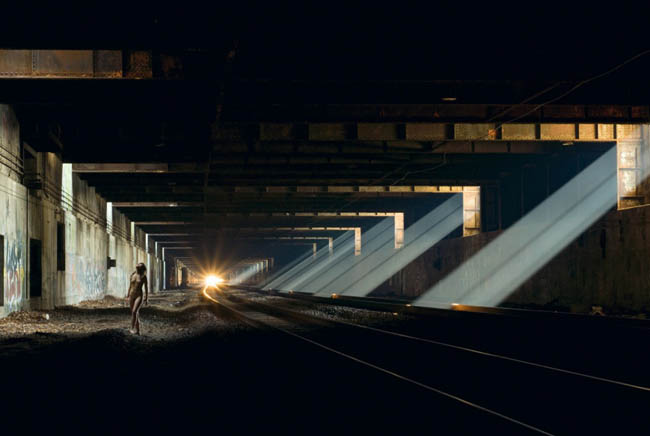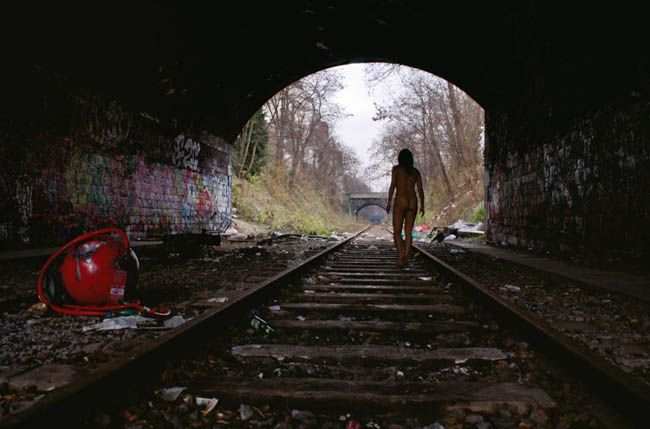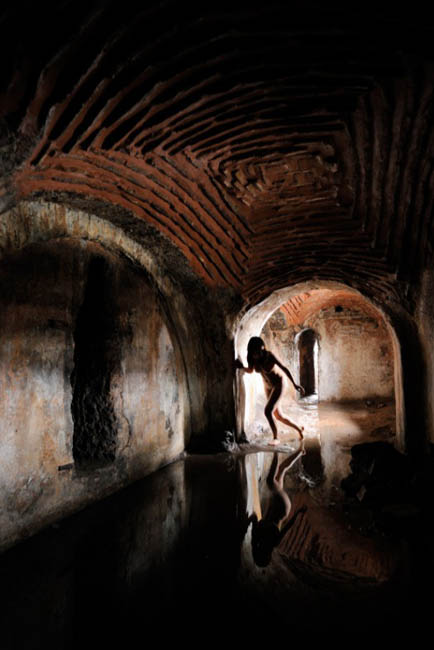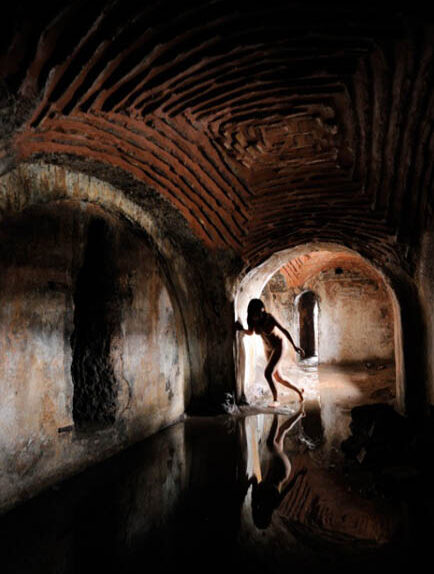NUDES NUDES NUDES
It’s got to be one of the most common visual tropes used by photography students in art schools: the attractive, thin, young woman posing nude in a rundown, dilapidated setting. An abandoned house, a derelict factory, a decaying former institutional structure such as a mental institution or a prison—it’s all been done. In fact, it’s all been done ten thousand times.
Yet Miru Kim has made a name for herself shooting exactly that sort of photograph. What is there in her work that lifts it above the photographs of those tens of thousands of other young photographers? Why did she gain recognition and artistic credibility while so many others didn’t?

Kim was born in 1981 in Stoneham, Massachusetts, just a few miles north of Boston. She was still a child when her parents (her father is a noted philosopher, Young-Oak Kim, also known as Do-ol) returned to Seoul, South Korea. In 1995, at the age of thirteen, her parents sent her back to the U.S. to attend the Phillips Andover Academy, a rather exclusive preparatory school in Massachusetts. Given that she was a foreign student and not very proficient in English, her prep school years were difficult. She felt alienated and isolated from the other students, from the staff, from just about everybody.
After graduation, she matriculated to Columbia University in New York City for her bachelor’s degree, then obtained an M.F.A. from the Pratt Institute. As part of her studies, Kim spent a semester at Berlin’s University of the Arts, a semester that would help shape the course of her artistic career. Clearly, from 1995 to 2006, Kim was given the very best education money can buy.
A good education, however, doesn’t guarantee happiness. Kim apparently never quite overcame the social alienation of her school years. That social isolation continued even after she graduated and took a job working as a designer for political marketing company. On several occasions she’s spoken of her “feelings of isolation and loneliness,” much of which she attributes to “having moved alone to the U.S. at age thirteen without knowing the language.”
Even though she didn’t feel very connected to the people around her, Kim was enamored with the city. “Ever since I moved to New York, I knew I would have to make it my hometown…. My real passion is the city itself, especially the hidden layers.” One rather peculiar manifestation of that passion is Kim’s fascination for the quintessential city dwellers: rats.
The strange allure of rats and their subterranean existence merged with an experience she had while a guest student in Berlin. She’d met some students who were living in what had had been an asylum before it was bombed in WWII.
“They gave me access to their basement, which was totally fantastic. It was a huge catacomb-like structure that had roots growing everywhere over old bricks…. It looked cool, so I went in there and I started shooting. But I wanted to put something else in there…a figure, a living thing.”
Like so many other photographers Kim turned to the model of greatest convenience, herself. She set her camera on a tripod, removed her clothing, and began taking photographs.

Every city in every nation in every era has had two things in common. First, a thriving population of rats. Second, they’re always in a constant state of collapse and repair. Kim’s interest in that second aspect is shared by an international subculture who refer to themselves by a variety of names: urban explorers, building hackers, urban spelunkers, guerilla historians. Regardless of what they call themselves, these people share a compulsion for investigating and surveying the abandoned infrastructure of the city: the decaying buildings, the subway and underground rail passages, the sewers and storm drains, the steam tunnels.
Part of the excitement of exploring these out-of-the-way places almost certainly lies in the forbidden nature of it. It’s always exciting to trespass in those places you’re not supposed to go. But many urban explorers also share a genuine intellectual curiosity about the hidden physical history of a given city. On top of that, there’s just something romantic and adventurous in nosing about in the abandoned ruins of old places.
For Kim, the draw is the uncultivated, feral beauty that can be found in such places. And yet, the beauty alone isn’t quite enough. She believes the empty spaces need a human figure to make them “more familiar and peaceful.” Why a nude figure? Because “clothes make the living being too culturally specific and time-specific…. I started noticing how these spaces transform as soon as I take off my clothes and walk around.”
I’m not entirely convinced that transformational facet of her work is revealed in the photographs themselves, but it may nonetheless be a critical part of her process. If undressing makes the difference for her, then that’s reason enough for doing it.

Kim usually works alone, or with the help of her sister SeungJung (who also occasionally steps in as the nude figure in the photograph). One might understandably think it would be dangerous for a small woman to walk around naked in these locations, even if she’s accompanied by her sister. Kim doesn’t dismiss the danger, but suggests the risks aren’t as severe as most people think.
“I am very cautious not to do things that would risk my health, such as falling through old floors, getting burnt in steam tunnels, breathing asbestos or toxic fumes, stepping on nails, getting into fights, touching mold, etcetera.”
Kim doesn’t take any sort of weapon with her when she’s exploring or shooting. In fact, she claims her nakedness is a sort of defense. “If you think about it,” she says, “if you see some woman naked in an abandoned building, it’s kind of scary.” On one occasion she was shooting in an abandoned subway tunnel—alone and naked—when a man walked in on her. “I was so scared,” she told an interviewer. She dressed quickly and explained she was working on an art project. “Then I saw it was just this old guy who looked pretty harmless. He just lived there.” She asked his permission to keep working, then undressed and shot several more frames. Afterwards, the man offered her his shirt to wipe her dirty feet.
On another occasion, Kim found a dead body while exploring beneath Washington Heights in New York City. Yet the moment she describes as the very worst was when she stepped in a pile of feces while shooting in an old cement factory in New Jersey. “In my bare feet. That was worse than the dead body.”

As the project grew, Kim gave it a title: Naked City Spleen. The title is drawn from one of New York City’s many nicknames—the Naked City—and from a book of poetry by Baudelaire: Le Spleen de Paris. Baudelaire’s poems were written in praise of the beauty of life in the ‘modern’ city (or what was modern in the middle of the 19th century). The title of the project, clearly, is somewhat tongue-in-cheek.
Naked City Spleen, as a project, is over—partly because Kim is moving on to other projects and partly because she says it’s getting more difficult to find ‘new’ abandoned spaces. The combination of gentrification and post-9/11 security measures have reduced the opportunities for urban exploration. “It’s really too bad,” Kim says. “Everything is being turned into condos. It’s all disappearing.”
She’s wrong, of course. It’s not all disappearing. Cities are always falling apart and rebuilding over the old bones. Those bones may be getting harder to access, or they may be found more easily in somewhat smaller cities, but there’s always a new pile of bones being buried.
So to return to the original question—what is there in the work of Miru Kim that lifts it above the photographs of all those earnest young art students who’ve shot similar images? In terms of subject matter, nothing at all. The trope remains the same: a young, thin, attractive woman posing nude in a decrepit setting. The difference is the lengths to which Kim has gone to find those settings, the dedication required to make the photographs in such settings, and the commitment with which she approached the project.
Is that enough to set her aside from the tens of thousands of art students who’ve used the same trope? At the heel of the hunt, I’m inclined to say yes, it is. Kim’s work isn’t really about a nude woman in decrepit places; it’s about the decrepit places. The nude woman, in the end, is just another compositional element.

